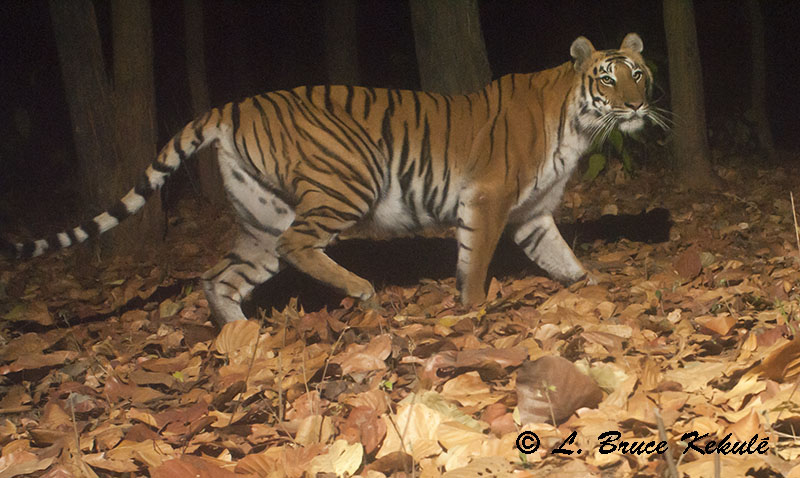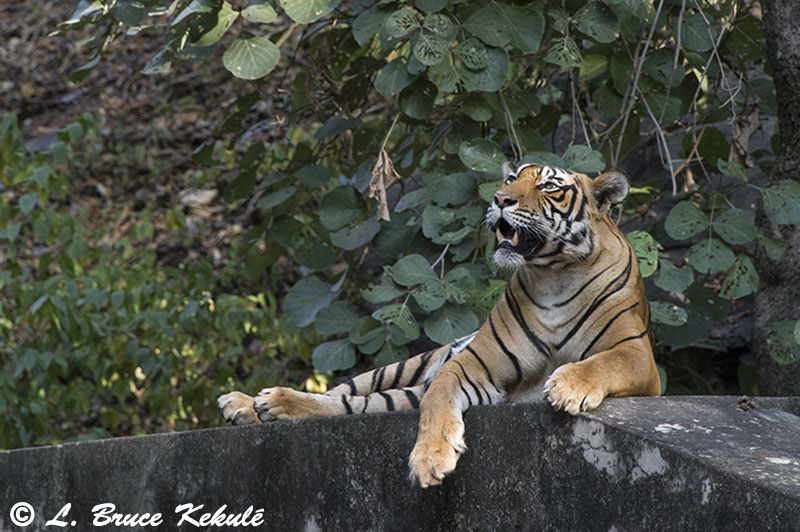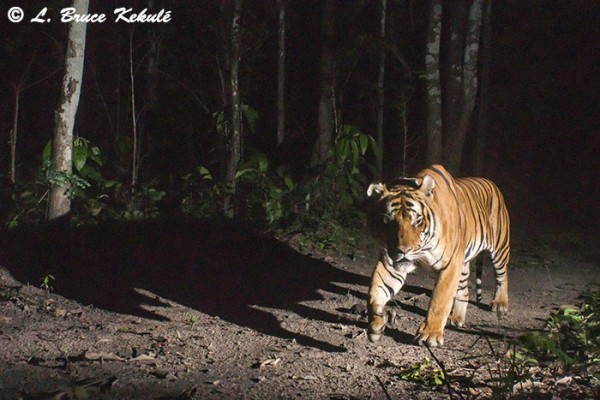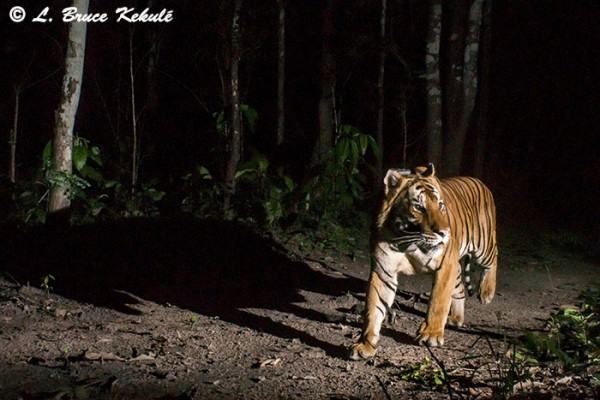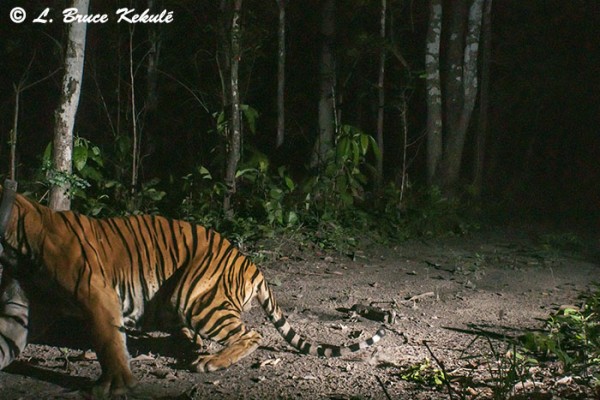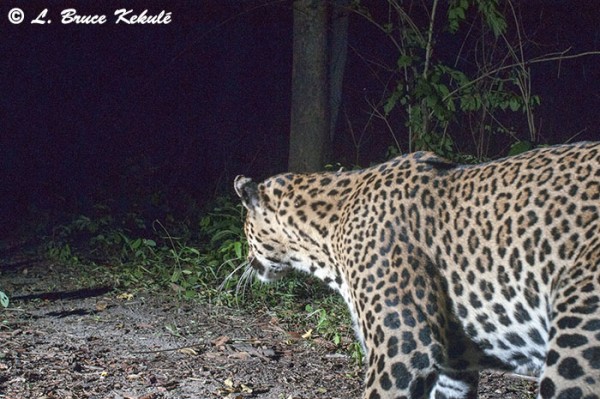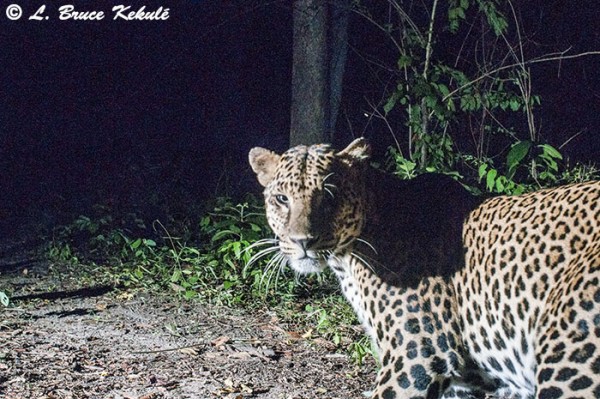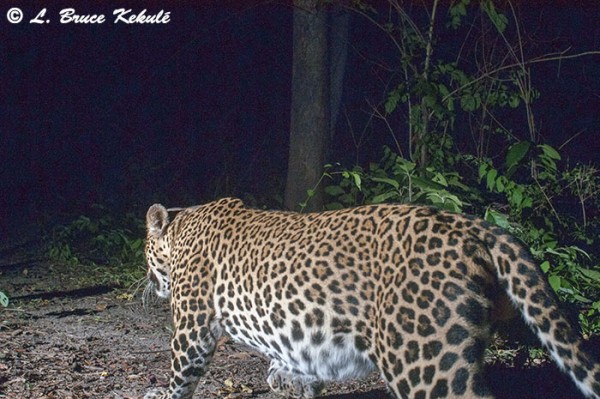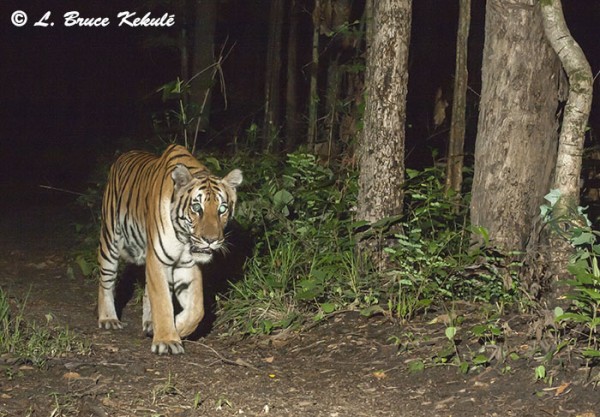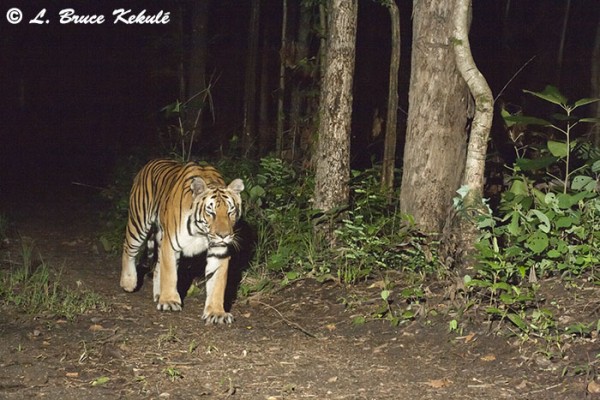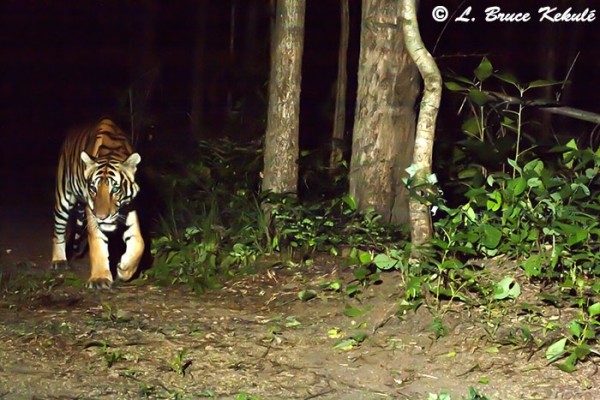Posts Tagged ‘Asian carnivore’
Eight tigers in two-weeks…!
A month long safari to the Indian sub-continent
Collarwali, the ‘Queen of Pench’ passing in front of my jeep; she has had 22 cubs and 6 litters and is one of my favorite tigers in India…!
India is a spectacular wildlife paradise showcasing the magnificent Bengal tiger. There is about two thousand thriving on the sub-continent and it’s the largest population remaining on the planet. These big cats still thrive very well in many protected areas and even outside some parks and sanctuaries, and at times are quite easy to see. However, they can also be very elusive and it really depends on one’s luck.
I arrived in New Delhi on March 20th at noon from Bangkok, Thailand, which takes about three and half hours flying time. Air India is a great airline and allows 40 kilograms of check-in baggage on business class which I needed as I had two DSLR camera traps, two sensors and four flashes, plus other assorted photographic equipment like my tripod, boots and clothes, etc. My two bags were very close to that limit and I hate paying overweight…!
I stayed in Delhi for one night and then caught the train the next afternoon going north to Ramganga city arriving in the evening and staying at the Tiger Camp Lodge on the way to Corbett Tiger Reserve and National Park. I slept well after the four-hour train-ride that is hectic going through Old Delhi train station fighting thousands of people to get on board. It is a madhouse…!
VANGHAT WILDLIFE RESERVE
The Vanghat female tiger camera trapped with a Nikon D3000 trail cam…!
The next morning, my first stop was Vanghat Wildlife Reserve and Lodge (private land) situated on the Ramganga River which is reported to have tiger, leopard, crocodile and other creatures common to the Corbett Landscape in the lower-Himalayan Mountains. The owner, Mr. Sumanthn Ghosh is an avid nature lover and was eager to see what was roaming his forest and hills. Little did he or I know that a female tiger was around and tripped my Nikon D3000 camera trap on the night of March 28th up on a ridgeline. She turned out to be prime female living in her patch.
CORBETT TIGER RESERVE
‘Parwali’ female tiger in Corbet Tiger Reserve with a spotted deer (chital) fawn…!
The next morning, I went into Corbett National Park to visit the grasslands at Dhikala Lodge run by the government where many tigers roam looking for prey. On the second morning, we bumped into a female that was hunting across the Ramganga River. Timing was perfect and she stepped on to the road with a spotted deer fawn in her mouth. It certainly was a once-in-a lifetime shot for me and I was pleased to say the least. Over the next few days, I saw her a few more times here and there. At that moment, Parwali (her name) is the most photographed tiger in Corbett and I feel lucky to have captured her with prey; behavior is tough with tigers..!
PANNA TIGER RESERVE
Panna’s larger female cub of T-1 on my first afternoon safari…!
From Corbett, it was back to Delhi on the train followed by anther train ride going further south but this time it was an overnighter. At my age, sleeping on a train is almost impossible and it was a long night. The next morning, we arrived at Khajuraho station and a driver was there to pick me up and drive to the Ken River Lodge owned by Mr. Shyamendra Singh on the Ken River not far from the main gate into Panna Tiger Reserve.
Panna’s smaller cub of T-1 on my last afternoon at a secluded waterhole by the road…!
That afternoon, Mr. Shukra, a very experienced guide and I entered the park at 3pm and in the late afternoon, saw a female cub from T-1 at a waterhole taking a drink. (Panna lost all their tigers in 2008 and she was the first reintroduced tiger). On my last safari, I bumped into T-1’s other smaller cub. Now that was some seriously good luck.
PENCH TIGER RESERVE
Collerwali yawning after a late morning slumber not far from the Pench River…!
Then after a long 8-hour taxi ride, I ended up in Pench Tiger Reserve southwest of Panna, and met up with my good friend Omeer (Omi) Choudhary, a guide, driver and naturalist for the Tuli Tiger Corridor Lodge. Over the next couple of days, he put me in front of Collerwali, the ‘Queen of Pench’ and the most famous tigress with 22-recorded cubs and 6 litters. I also saw two of her latest cubs, a male and female. And then Omi put me in the right place near closing time to catch Mr Big known as ‘Raiyakassa’ as he walked up from a mud bath. It was hot and he was cooling off.
Collarwali’s male cub watching the jeeps with the queen resting behind him…!
Collarwali’s female cub resting on a rock during a late morning safari…!
Raiyakassa, the male tiger and Collarwali’s mate just up from a mud-hole…!
That was it — eight tigers in two weeks. I guess I was lucky but I did pray to ‘Jim Corbett’s spirit plus the spirit of the Banyon Tree; Sitti Mama. She knew what I wanted and provided me with some amazing tiger shots… Overall, a successful trip and one that will be etched in memory for as long as I live…!!
Nikon D3000 DSLR ‘travel cam’ catches a female tiger in India
Awhile back, I published a post on ‘my travel cam DSLRs’ on this forum and got some nice mongoose pics from that set last year. I have just wrapped up another trip to Northern India where I set one of my D3000s on a trail in a place called Vanghat resort and private wildlife reserve not far from Corbett Tiger Reserve in the State of Uttarakhand. After only two nights, a female tiger walked past the cam and tripped the sensor several times…this is the best shot from the series…Lady luck doing her magic once again…!!
Nikon D3000 with a 24mm manual lens – 2 SB-28s set at 1/4 power..!
Settings: ƒ8; 1/250 sec; ISO 400.
Pench Tiger Reserve: A fantastic trip with a close friend…!
An amazing forest in India’s Madhya Pradesh with some truly beautiful tigers…!
Collarwali on her way to the Pench River for an early morning drink…!
Being at the right place and right time always works. I arrived at the Tulie Tiger Corridor Resort close to Pench Tiger Reserve in the late evening of April 2nd and was greeted by my very good friend and naturalist, Omeer (Omi) Choudhary. As it was late and I was totally bushed from a long haul (airline flight from Ahmedabad in Gujarat visiting the Blackbuck-Velavadar National Park, and then a grueling 3-hour taxi ride from Nagpur), it was straight to bed for an early start the next morning.
Collarwali the next morning yawning after a long sleep…!
Up at five and after quick coffee and gate formalities, we entered the park at 6am and drove to the other side of the park (one hour drive) where the famous female tiger ‘Collarwali’ of Pench and her two cubs were being seen. That morning, I got a glimpse of ‘stripes in the grass’ and that was that. In the afternoon, one of her cubs was lying in the dense bush and I was able to get some good shots.
One of Collarwali cubs resting in the afternoon…!
The next morning however as we were sitting in the jeep waiting on some action, ‘Collarwali’ step out in front of us and walked down to the Pench River. It was great to see her again in lovely morning light. She is one of my favorite tigers in India…!
Collarwali’s other cub with mother in the back…!
The next morning and final day of my safari, I paid respects to the ‘Spirit of the Banyan Tree’ with a coconut and some joss sticks at the gate. After a 40-minute drive (short-cut), we found ‘Collarwali’ sleeping with a cub on a big rock and I got both of them together but at distance.
Raiyakassa, the dominant male tiger walking past the jeep all muddied up from a snooze in the big pond…!
In the afternoon very near closing time, we bumped into a leopard (rare for Pench) and I got a few shots. Then, as we were motoring back to the lodge just before the deadline of 6:30pm, we bumped into the dominant male (Collarwali’s mate Raiyakassa) walking towards us from the big pond. He was half covered in mud but still a magnificent creature and I was able to get a bunch of great images as he walked very close to our jeep. It was that good old ‘right time and right place’ and the ‘Spirit of the Banyan Tree’. What a fitting end to my second trip to Pench and I would like to thank Omi for his wonderful spirit and friendship…I will miss him..!
Raiyakassa caught head on…he is truly a beautiful male tiger and father of many of Collarwali’s cubs (22 cubs-6 litters)…!
As most people know now, Pench recently lost the Baghin Nala female and two of her cubs to poisoning on March 28th. This is very unfortunate for the park, Forest Department and people who love to see tigers. Fortunately, the other two cubs were saved and shifted to Kanha as they surely would have died too. It could take sometime for another big cat to fill this void and the danger will still be there of future poisonings.
On a good note, some of the poachers involved in this case have been apprehended and the others are being sought after. This incident plus others (27 tigers killed by poisoning and other circumstances in India since the Jan. 1st) is a growing trend and the ruthless Chinese tiger bone medicine devils are behind this. Somehow it must be stopped now or more tigers will be lost to this mindless draconian practice…!!
Canon 400D catches two male leopards: But poor camera placement affects the image..!
A black and yellow phase leopard caught on trail cam
After the dry season when the first monsoon rains arrived here in Thailand this year, I decided to go back to my old stomping grounds where tigers, leopards and other Asian species travel back and forth down a wildlife trail deep in the Western Forest Complex of Thailand. Last year, a bull gaur charged me not too far from this location and it still brings shivers down my spine when I look back on that incident. However, it is one of my favorite sites to catch the denizens of the Thai forest on camera traps.
Spotted leopard caught in the afternoon.
A couple months ago, I pulled out my first DSLR trail cam that had been rumbling around in my truck for sometime. It’s a Canon 400D with a Nikon 50mm manual lens that uses an external hard-wired SSII (Snapshotsniper) sensor and three hard-wired Nikon SB-28 flashes. The camera is housed in a Pelican 1150 encased in one of my ‘elephant proof’ aluminum boxes and firmly bolted to a tree just by the trail. When I set the cam, it was pointing a bit high and the framing was off. Of course I did not notice it at the time of installation. I recently posted somewhere that sometimes if takes a little experimentation and adjustment to get the composition just right. This is one of those times…!
Black leopard caught in the morning.
The cam has been on that tree for almost two months now, and I decided to go and service it. A female muntjac (barking deer) had passed but on August 22nd at 3.40pm, a yellow phase leopard passed the Canon that ripped off six quick shots. Then on August 28th at 8.26am, a black leopard got caught going the other way and tripped the cam for another 6-shots. Funny enough, both cats are males. For some reason, the flashes were not powerful enough and the images of the black leopard are underexposed with loads of noise. I have tweaked them a bit but they are what they are; good record shots.
Common red muntjac or barking deer female
A female on the run…!
I have re-adjusted the cam for better framing and put in another flash near the sensor down low (switched to radio flash triggers). Hopefully that will lighten things up a bit in the target area. Replaced the batteries, card and desiccant, and tested the system. Seems to be working OK. This highway in the forest should produce more mammals as they go about their daily lives. I now have four DSLRs working in this forest: a Nikon D700 at the ‘tiger log’ and a Nikon D90 just up the trail a bit, plus another Canon 400D at another location and then this Canon. Hope to get one of my Canon 600Ds and a couple Sony DSLRs going soon with different locations and composition. Enjoy…!
Tiger, tiger burning bright…!
A visit to Ranthambore and Bandhavgarh national parks and tiger reserves in India
Sultan the Great of Ranthambore National Park and Tiger Reserve: My favorite shot as he was looking right at me….!
Several months ago, I found someone on Facebook offering a ‘workshop tour’ to some of India’s most famous tiger reserves. At first I was hesitant but after he discounted the trip a $1000 thinking he had assembled a fair sized group, I decided to take the plunge. By that time I had looked at his website and he has some nice images of birds and other animals from around the world. I thought he was a professional. The schedule looked good and we were going to visit three parks over the course of two weeks.
He will be referred to as ‘Mr. Workshop’ from now on. I sent an email to him in Eastern Canada and it was a go. Funds were sent and everything went good for a while. Then the funny email came that he had switched tour companies in India, and some of the schedule and hotels had also been changed. We were now doing only two parks but the overall timeline had not been altered. He also needed another $500 claiming a miscalculation. It then became a worry…! Was this a scam I asked myself…?
I called him and he seemed OK so we were still on. I got a visa to India that was difficult but finally approved by the Indian Embassy in Bangkok a week before departure. I boarded Air India to New Delhi and landed at noon on November 4th just last month. Immigration and customs was pretty straightforward and my luggage arrived in one piece.
‘Ustad’, my first tiger in Ranthambore walking in the forest by the road….!
Mr. Workshop was suppose to meet me at the airport but was no-where to be seen. I opened my laptop looking for the hotel address and got a prepaid taxi (no A/C) for a hell-bent-for-leather horn-blasting ride through the city, and finally arrived only to find out he was at a sister hotel on the far side of town. The thought of scam raced through my brain again…!
So I jumped in another taxi and eventually arrived at the other hotel. He was with a senior lady bird-watching friend from New York and she had gone to Costa Rica with him on a bird tour. So it was only the three of us…! We had dinner, and I hit the sack and crashed after all the crazy mind-blowing travel through Delhi. We were all set to leave first thing the next morning at 6am to beat the traffic out of the city.
After a quick cup of coffee and some breakfast, we departed for the first leg of the tour. We had a nice medium sized car with A/C and a driver with some English skills. It was a six-hour taxi ride south to the hectic town of Sawai Madhopur, close to Ranthambore tiger reserve in northwest India.
‘Ustad’ stopping for some claw scratching….!
We got to the hotel (Ranthambore Regency) at lunchtime and then the news came that only two rooms were available, and I would have to bunk with a stranger. I was not happy but refrained from making any trouble as we had just begun the safari so I reluctantly agreed. I knew it would be uncomfortable and it certainly was going to be a problem down the road but decided to ride it out. He is actually a skim-artist ordering only two rooms from the agent as I found out later…! He took it for granted that it would be OK for him to bunk with me as if we were buddies. I would of course regret that decision.
In the afternoon, we went out on our first ‘game drive’. By then I was all pumped up to see a tiger in the wild. We were in prime big cat habitat. However, the ride to the park entrance was an eye-opener. It is absolute chaos going through any market place in India with people, cars, pollution and rubbish everywhere, plus cows, pigs and camels all over the place, and horn blowing like I have never heard in my entire life.
Even my first trip to India in 2013 was not this bad. I was dumb-founded and did not think I would survive this marketplace again. Close calls and near misses on the road were frequent. We finally got to the gate and entered the reserve. A hat, facemask and sunglasses are a must when traveling through most sections of rural India…!
Ustad close by but very calm around the jeep hordes….!
Day one was absolutely the roughest off-road ride I have had in a long time and I got bounced all over the back seat of a small Suzuki-Maruti jeep (called ‘Gypsy’ in India). We saw loads of prey species like sambar deer, spotted deer, Nilgai (blue bull) antelope plus peafowl, monkeys and many other denizens of the Indian forest but no tiger.
Up at dawn for the first of two drives a day (one in the morning and one in a afternoon). Day two was even rougher as we traveled to another zone up to the top of a mountain. After two days, still no sign of a tiger. I was beginning to wonder if we would see one at all as there were quite a lot of tourists and jeeps about.
But day three was magic as we bumped into a huge male tiger first thing in the morning walking parallel to the road. When you see a tiger in the wild some 20 meters away, you then realize how big these cats really are. We followed him for a while before he disappeared into the bush but reappeared further down the road again for some more shots. It was absolutely great seeing and photographing this iconic apex predator.
Noor’s tiger cub hidden in the bush…!
We then moved to another area where we found loads of jeeps huddled around another tiger named Noor plus two cubs but we could not get close enough for any real good shots as it was packed solid. I did manage to get a couple quick images of a cub and Noor a little later on when she went out hunting leaving the young ones hidden in the grass. We had seen and photographed three tigers in the wild during the morning drive. The afternoon was quiet again. That evening, I had a few beers in celebration.
Day four was the same drill: up at dawn but was less hectic getting into the park as we took another route. Up into the forest we went and ended up in a canyon bumping into Sultan sleeping on a ‘weir’ (concrete check dam). The driver was an expert and got us into a great position directly across from the big cat at eye-level. Mr. Workshop refused to photograph this tiger lying on the concrete saying it was unnatural.
There are stone and concrete structures all over Ranthambore and some date back centuries that have become part of the habitat for so long that tigers use them all the time to rest up and hang out. I began to question his mentality and logic. Come this far after a tiger and complain about the backdrop.
Noor looking after two cubs out hunting in mid-morning….!
I used two cameras on this trip: a Nikon D300s with a Tamron 70-200mm ƒ2.8 lens for my offhand camera, and a Nikon D3s and a Nikon 200-400mm ƒ4 VRII telephoto lens plus a 1.7 converter (for 340-680mm) as my main rig, and used it in conjunction with a Gitzo lightweight ‘Traveler’ graphite tripod and Wemberley gimbal head. I was able to lock onto the sleeping feline without any strain, and be instantly ready for any behavior and movement.
After an hour, Sultan finally woke up and I did not stop shooting. By that time, some 40-50 vehicles had showed up with at least three hundred people behind us and it was complete madness with almost everyone talking at once and jeeps crashing into each other jockeying for position. Everyone wanted to see him. He is probably the most famous tiger in the park now.
On day five, we were lucky to get the same zone again and headed straight back up the canyon. ‘Sultan’ was sleeping close to a water hole and the road, and we got within six meters of him. I went after the close-up head shots and got some really amazing images of this three and half year old mature tiger. He then got up and we moved in further, and he came and flopped down in front of us. It certainly made me very happy. Lady luck was on my side.
Sultan resting on a weir (check dam)….!
In late afternoon that same day as we were traveling by the lake going back to the lodge, we bumped into a large group of trucks and jeeps that had gathered by some tall elephant grass with everyone pointing at something moving in the bush. We moved closer and by sheer luck, Krisha, female tiger stepped out to the left of us. She then moved behind and crossed the road. The driver went into reverse and got us in front of her. I managed to get some very nice head-on shots with a beautiful back-lit scene. Another tiger was in the bag making it five separate sightings. My spirits were high as we returned to the hotel.
However, Mr. Workshop started to get annoying wanting only two things: to photograph tigers and kingfishers. I thought this odd as this trip was meant to be a workshop (as he called it) and I thought we would photograph everything wild but this was not to be the case. His promise that the clients had first priority in the beginning of this tour quickly went out the window. I did not say much and just clammed up deciding to be quiet but the ill feeling continued. I concentrated on getting as many images as possible.
Up from his slumber….!
Day-six and seven was quiet with no more tiger sightings other then some pug marks here and there, plus the usual deer, antelope and birds. It was like we were winding down after all the tiger excitement. We left the hotel that evening and arrived at the train station for the great ‘Indian’ 12-hour train-ride further south that went throughout the night. We were assigned to three sleeper-bunks but I felt extremely uneasy after hearing many stories from friends about train rides in India. But we arrived safe and sound the next morning at Jaibalpur and were met by a designated taxi driver at the train station.
Checking his surroundings….!
The ride to Bandhavgarh National Park and Tiger Reserve took about three and half hours to the hotel (King’s Lodge). During the ride, I decided that I would not be bunking with Mr. Workshop anymore and that he could bunk with his birder friend but that brought out a shriek of terror from her. So I told him to find his own room. It looked like he had been slam-dunked, or an ice bucket put over his head.
Sultan yawning showing his canines…!
We stayed there for four more days and I kept my distance during breakfast and dinner, and we hardly talked at all while in the jeep. He was ticked off that he now had to fork-out cash (mine) for a room. I was totally disgusted with his behavior and I figured no more dialog was the best remedy. He was also extremely rude and showed his arrogant attitude towards anything he did not like or care about.
Unfortunately, we did not see any tigers in Bandhavgarh but there were many pug marks in the dust on the roads telling me the big cats were mainly nocturnal here and would disappear into the bush at first light and come back out at dusk. Poaching pressure was probably the main problem.
Sultan just six-meters away the next morning….!
A natural occurrence also happened last year when a male tiger killed three females to bring them into estrus (breeding) plus all their cubs had been killed. It was a blow to the park but just part of natural selection. After talking to some English wildlife photographers that had been coming since 2008, they said this year was way down on sightings and photographs from previous years.
The only neat thing for me at Bandhavgarh was the fact that I got some great camera trap videos of two ‘jungle cats’ coming to some chicken bait behind my lodge where I set a Bushnell Trophy Cam. These cats have become rare throughout their range and it was neat seeing them. I will be sharing these videos with the naturalists at the hotel so they are aware that these rare cats live there.
Sultan looking ‘straight down the barrel’…My last sighting of this magnificent cat….!
The thing that struck a wrong cord with me about Mr. Workshop was his claim to be a professional photographer. He brought his lens to the jeep in a roll-on bag made for an airline overhead bin to fit a long lens, and he would get dust all over the camera while in the jeep and then just put it back into his bag at the end of every safari. He also would sometimes leave the zip undone and dust poured in during travel around the dirt roads in the park. He complained about the focusing ring being stiff. He also used his shirt to clean his lens.
I brought my cameras to the vehicle on my shoulder and when I got back to the room, would quickly take a wet cloth and wipe the camera and lens down with a moist towel and clean all the nooks and crannies with a toothbrush. I paid special attention to the lens using a blower and special lens brush. My roll-on bag stayed in the room where it was dust-free. I took my cameras back to Thailand without hardly any Indian dust; it is deadly stuff and will damage fine equipment fast…!
Krishna was my fifth sighting in Ranthambore. It was absolutely amazing but a bit stressful due to the overload of tourists…!
Ranthambore National Park and Tiger Reserve: The protected area is situated in Rajasthan State in northwest India and is best known for its historical medieval fort, and is believed to have been built in 944 AD by the Rajputs. The massive battlements dominate the cliffs overlooking the lake where many other structures and temples dot the landscape. But the park is most famous for its tigers. The great tigress named ‘Machli’ who fought off the advances of many males is still going after 19 years and can be seen from time to time but is near the end of her days. And the first male to dominate her in a fight is ‘Sultan’ and he can be found in several zones in the park that is divided into 10 separate areas where tourists and photographers can enter. There are many males and females with cubs and depending on your luck, you may bump into one of these magnificent cats. I saw five tigers over three days during my stay in Ranthambore.
Bandhavgarh National Park and Tiger Reserve: This land of valiant medieval kings was the bastion of the 12th century Kalchuri dynasty – and is situated in a vast verdant forest of Madhya Pradesh in Central India. This scenic region has a rich historical past and civilization that can be traced back some 2,000 years. The protected area is spread over 448 sq. km and was the private hunting grounds of the Maharajas of Rewa. The first ‘white tiger’ was spotted here. Sadly, they no longer can be found in the wild but only in zoos. The famous tigress named Sita made Bandhavgarh famous, as did a male tiger named ‘Charger’ (he made mock chargers on jeeps hence the name). Documentaries produced by National Geographic about tigers and other creatures found here. However, I did not see any tigers in Bandhavgarh but there were loads of pug marks on the roads telling me the big cats were mainly nocturnal and would disappear into the bush at first light and come back out at dusk. Poaching pressure is probably still a problem. Sightings are now quite rare as the tigers have become wary of humans. After talking to some English wildlife photographers that have been coming here since 2008, they said this year was way down on sightings and very photographs of tigers have been taken.
Conclusion: The moral of this story is never trust anyone on Facebook if you don’t know them personally as it could end-up far worse than what I experienced. I was lucky and got my tiger shots plus many other beautiful Indian creatures, but the stress and aggravation of being with someone who was not truthful, arrogant and non-professional was very difficult to cope with. I have learned my lesson and will never ever go on any so-called ‘workshop tours’ found on Facebook. I also know of another individual in Bangkok who scammed some Thai photographers on a ‘tiger tour’ to India off of Facebook…!
If you have a passion to see a tiger in the wild, go on Google and surf the net, or find someone through a national publication like Wildlife Photographer or some other outdoor magazine, or contact the hotels and lodges directly found on the Internet offering tiger tours in India. Many of them are good but it can be hit-and-miss sometimes so try to choose wisely. Check references and follow-up on everything that is not ‘crystal clear’.
Sony A500 catches a male tiger with a ‘radio collar’
A male Indochinese tiger in the Western Forest Complex of Thailand..!
What are the odds that my DSLRs would capture two different tigers sporting radio collars within one week of each other..? These are real fluke camera trap shots taken some twenty kilometers away from my Nikon D700 that caught a female also with a collar at the ‘tiger log’. I just posted this on this website a couple of days ago. http://brucekekule.com/camera_trapping/nikon-d700-catches-an-indochinese-female-tiger-sporting-a-radio-collar/
The Sony A500 was triggered by a male tiger on Sept. 17, 2014 at 10:26 PM while the D700 got a female on Sept. 24 at 5:45 AM. I only captured two tigers this trip and it seems weird that they both have collars. Maybe the ‘spirits of the forest’ wanted me to really show and tell the world what is actually going on in this forest concerning tigers. Who knows..?
Needless to say, I’ve already vented my feelings about tigers and radio collars in my recent D700 post so there’s no sense in going there again. However, the A500 got a nice string of shots of this male with a huge collar. I think the battery is on the bottom and transmitter on top. This monstrosity surely looks heavy..!
Unfortunately, only one flash on the right triggered which was a bit of a let-down. The other flash was up high on the tree pointing down at the tiger and would have cancelled that shadow. It was one of those things and there’s always next time. The A500 fired four quick shots and as the big cat jumped forward, triggered another five as he leaped to the right. All in all, I was still pleased with the results and look forward to a ‘black cat’ that I once videoed in broad daylight at this very location.
Noise is also a problem with these images, as I had to do some heavy tweaking in Camera Raw and Photoshop to get them to acceptable levels. If I had been shooting in JPG. format, there would be no chance to bring these back. RAW capture is the only way to revive images when things get dark with not enough light.
I’m not sure if this is inherent to Sony but I think most makes and brands with low light means serious noise although the newer pro-cameras handle noise quite well. The settings are: ƒ8 – 1/80th – 400 ISO…flash set to ¼ power, and lens was a Minolta 28mm (old lens I have had for years). It’s a wonder I got these shots at all..!
Oh well, back to the drawing board on flash standby power. I’m putting together a couple Nikon SB-28 and SB-600 flashes that will work with hard-wire or radio triggers with four Eneloop AAs in the flash and four rechargeable ‘Ultracell ‘D’ cells with 11,000 mAh capacity as externals to add more power for longer soaks. This will all fit in a lockable ‘Tupperware’ type box as shown.
I will try these on the A500 first to see if there is a difference with staying power. I also believe that three or more flashes are the ticket for well-lit shots…I know Steve Winter with N.G. sometimes uses from 4-5 flashes depending on terrain.
It’s a never-ending battle with the DSLRs but I guess that’s what I like about using them: the challenge to get tigers and leopards on digital camera plus all the other cryptic animals in Thailand’s forests…it all becomes worthwhile when I do get a shot or shots…! Enjoy.
Nikon D300s catches an Asian Leopard
A male cat shows off its family jewels…!
A male leopard with its reproductive organs in full swing…Shot No: 6.
Back at the end of June, I pulled a card from my D300s DSLR trail cam at the ‘big cat trailhead’ and when I looked, I did not see anything so I threw the card in the with the rest of my CF cards.
Shot No: 1
It was somehow put into my D3s but fortunately I did not format it. After doing some work while in the forest last week, I pulled both cards (Nikon D3s had two CF card slots) and downloaded them.
Shot No: 2
Imagine my surprise…! There was a male leopard and he had been captured at night while walking past the D300s. Where the heck did that come from…?
Shot No: 3
I guess my short-term memory is on the blink. Unfortunately, the other two flashes were dead creating a horrible shadow…!
Shot No: 4
Needless to say, I’m lucky I did not lose these shots and of course, shot No: 6 is my favorite…enjoy…!
Shot No: 5
Nikon D300s set to low continuous.
Nikon 35mm manual lens.
ƒ11 @ 1/125 ISO 400
Single SB-28 set to full (the other two flashes did not fire and were dead).
SSII sensor #6 chip – Pelican 1150.
Indochinese tiger ‘eye lash’ speed…!
A Canon 400D trail cam catches a male tiger
Old green eyes’…out on a ‘night prowl’…1st shot…!
A couple of days ago, I was checking my cams and got to my Canon 400D on a forest road somewhere in the Western Forest Complex of Thailand. When I got to the cam, it was still working but only one flash three feet above the cam was firing hence the ‘eye-shine’ . The other two flashes were dead…! Life on two Canon Lithium batteries in 30 second power save mode is excellent so I left them just to see how long they would really last….!
Tiger squinting…..2nd shot.
The flash that fired was a SB-26 which I normally set for slave but somehow the settings was on full-power…needless to say, I was delighted and did back-flips when I saw a tiger again, in about the same position as the female back in June in two shots. In both instances, the tigers had their eyes open on the first shot and squinted by the second in almost the same positions. This reaction time is measured in milliseconds…!
Last month’s female tiger…..1st shot.
Then they both jumped out of the frame before the camera could shoot again. This is 100% luck….also shifted the 400D over a tad to the left for better composition. I have included last month’s female tiger shots so a comparison can be made without having to flip back to the old post.
Female squinting…..2nd shot.
All I can say, it boggles the mind but shows how fast tigers can react……Enjoy…!
Canon 400D set to continuous
Nikon 50mm ƒ1.4 manual lens
Nikon SB-26 set to full power.
1/125 – ƒ8 ISO 400.
SSII sensor #6 chip – Pelican 1150
1st shot – cropped and the rest normal size.
Indochinese tigers in Thailand’s Western Forest Complex
Tigers’ reaction to camera traps and red LEDs
The following videos are a collection gathered over the last 6 months of tigers in the Western Forest Complex. Some of these wild cats showed reaction to red LEDs and the cams, but others did not seem bothered. What ever happens with some animals depends on the individual. Needless to say, there are quite a few tigers in this forest. I am trying to improve the quality of the videos with better cams that are in the process of being built…Enjoy…!!



